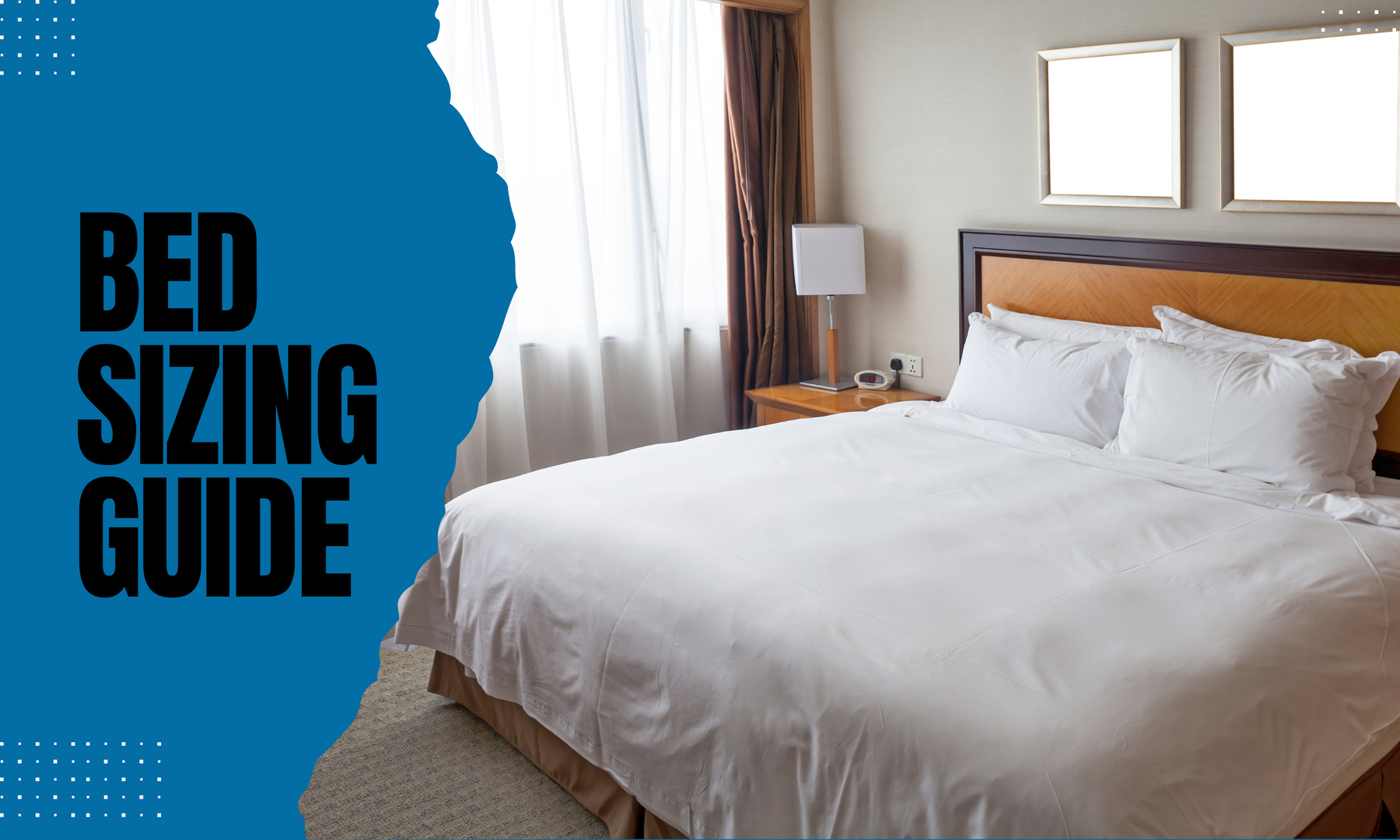

Bed Size Guide: Find the Perfect Bed for Your Needs
Waking up cramped, restless, or struggling to share your bed? You’re not alone. Many people unknowingly choose the wrong mattress size, leading to discomfort, disrupted sleep, and even wasted space in their bedroom. Whether you're squeezing onto a too-small bed or dealing with excess room you don’t need, finding the perfect mattress size is key to better sleep.
This bed size guide breaks down everything you need to know—from standard mattress dimensions to choosing the best fit bed for your space and lifestyle. Let’s start by understanding the different bed sizes and how they compare.
Understanding Mattress Sizes and Dimensions
Choosing the right bed size starts with understanding mattress dimensions. While the names (Twin, Queen, King) seem straightforward, their actual sizes can vary depending on the country and manufacturer. Here's what you need to know:
Why Mattress Dimensions Matter
-
Ensuring your bed fits comfortably in your bedroom.
-
Avoiding compatibility issues with bed frames and bedding.
-
Maximizing sleep quality by providing enough space for solo sleepers or couples.
Quick Mattress Size Comparison Chart
To make it easy, here’s a quick reference table of standard U.S. mattress sizes with their dimensions in inches, feet, and centimeters:
|
Mattress Size |
Inches (W × L) |
Feet (W × L) |
Centimeters (W × L) |
|
Twin |
38 × 75 |
3.2 × 6.3 |
96.5 × 190.5 |
|
Twin XL |
38 × 80 |
3.2 × 6.7 |
96.5 × 203 |
|
Full (Double) |
54 × 75 |
4.5 × 6.3 |
137 × 190.5 |
|
Queen |
60 × 80 |
5 × 6.7 |
152 × 203 |
|
King |
76 × 80 |
6.3 × 6.7 |
193 × 203 |
|
California King |
72 × 84 |
6 × 7 |
183 × 213 |
Pro Tip: Mattress sizes can slightly vary by brand. Always check exact dimensions before purchasing to avoid surprises!
Now that we’ve covered the basics, let’s dive into each standard bed size and which one is right for you.
Standard U.S. Bed Sizes with Dimensions
Choosing the right bed size depends on who will be sleeping in it, the available space, and personal comfort preferences. Below is a breakdown of each standard U.S. mattress size, along with dimensions and ideal use cases.
Twin (Single) Bed
-
Dimensions: 38” × 75” (3.2' × 6.3') | 96.5 × 190.5 cm
-
Best for: Kids, teens, and small guest rooms
-
Considerations: A good space-saving option, but too narrow for most adults
Twin XL Bed
-
Dimensions: 38” × 80” (3.2' × 6.7') | 96.5 × 203 cm
-
Best for: Taller teens, college dorm rooms, and single sleepers needing extra length
-
Considerations: Same width as a standard Twin, but provides more legroom
Full (Double) Bed
-
Dimensions: 54” × 75” (4.5' × 6.3') | 137 × 190.5 cm
-
Best for: Solo adults who want more space, small apartments
-
Considerations: Can fit two people, but space will be tight
Queen Bed
-
Dimensions: 60” × 80” (5' × 6.7') | 152 × 203 cm
-
Best for: Couples, guest rooms, and single sleepers who like extra space
-
Considerations: Most popular mattress size, offering a balance of comfort and room efficiency
King Bed
-
Dimensions: 76” × 80” (6.3' × 6.7') | 193 × 203 cm
-
Best for: Couples who want extra sleeping space, master bedrooms
-
Considerations: Requires a larger room to avoid feeling cramped
California King Bed
-
Dimensions: 72” × 84” (6' × 7') | 183 × 213 cm
-
Best for: Tall sleepers, spacious master bedrooms
-
Considerations: Narrower but longer than a standard King, making it ideal for those over six feet tall
Understanding these sizes is the first step toward choosing the right mattress. Next, we’ll compare U.S. sizes to bed sizes in the UK and Europe for those who need an international perspective.
Bed Sizes in the UK and Europe (for International Comparison)
While U.S. mattress sizes are widely recognized, they differ from standard sizes in the UK and Europe. If you're purchasing a mattress internationally or moving between regions, understanding these variations is essential.
UK Bed Sizes
The UK uses different names and slightly different dimensions for mattresses compared to the U.S.
|
Mattress Size |
Inches (W × L) |
Feet (W × L) |
Centimeters (W × L) |
|
Small Single |
30 × 75 |
2.5 × 6.3 |
75 × 190 |
|
Single |
35 × 75 |
2.9 × 6.3 |
90 × 190 |
|
Small Double |
47 × 75 |
3.9 × 6.3 |
120 × 190 |
|
Double |
53 × 75 |
4.4 × 6.3 |
135 × 190 |
|
King |
59 × 78 |
4.9 × 6.5 |
150 × 200 |
|
Super King |
71 × 78 |
5.9 × 6.5 |
180 × 200 |
Key Differences:
-
A UK Double is slightly narrower than a U.S. Full bed.
-
The UK King is closer in size to a U.S. Queen bed.
-
The UK Super King is slightly smaller than a U.S. King.
European Bed Sizes
European bed sizes tend to be measured in centimeters and vary slightly by country.
|
Mattress Size |
Centimeters (W × L) |
Inches (W × L) |
|
Single |
90 × 200 |
35 × 79 |
|
Double |
140 × 200 |
55 × 79 |
|
King |
160 × 200 |
63 × 79 |
|
Super King |
180 × 200 |
71 × 79 |
Key Differences:
-
European Single beds are longer than their U.S. and UK counterparts.
-
The Double size is wider than a UK Double but slightly smaller than a U.S. Queen.
-
European King and Super King sizes are similar to UK equivalents but not identical.
Important Considerations for International Buyers
-
Bedding Compatibility: U.S., UK, and European beds require different sheet and duvet sizes.
-
Frame Sizing: Buying a U.S. mattress for a European or UK frame (or vice versa) may lead to fit issues.
-
Custom Orders: Some retailers offer international sizing options, but they may cost more.
Understanding these regional differences ensures you choose the right size whether you're shopping locally or abroad. Next, we’ll explore how to choose the best bed size for your specific needs.
Mattress Size vs. Bed Frame Size
A common mistake buyers make is assuming that a mattress and bed frame will always match in size. However, bed frames often have additional dimensions due to design elements like headboards, footboards, or extra padding. Understanding the differences can help avoid compatibility issues.
Why Bed Frames Are Bigger Than Mattresses
-
Extra Border Space: Many bed frames include a small gap to accommodate different mattress brands.
-
Built-in Headboards and Footboards: These can extend the total footprint of the bed.
-
Storage and Platform Designs: Some bed frames have built-in drawers or platforms that add width and length.
General Frame Size vs. Mattress Size Guide
|
Mattress Size |
Approx. Bed Frame Size (W × L) |
Extra Space Required |
|
Twin |
40” × 77” (3.3' × 6.4') |
+2” in width/length |
|
Twin XL |
40” × 82” (3.3' × 6.8') |
+2” in width/length |
|
Full |
56” × 77” (4.7' × 6.4') |
+2” in width/length |
|
Queen |
62” × 82” (5.2' × 6.8') |
+2” in width/length |
|
King |
78” × 82” (6.5' × 6.8') |
+2” in width/length |
|
California King |
74” × 86” (6.2' × 7.2') |
+2” in width/length |
How to Ensure a Perfect Fit
-
Measure Your Space: Consider both the mattress and frame size before purchasing.
-
Check the Product Specifications: Manufacturers list exact dimensions, so verify before buying.
-
Account for Bedding: Some frames require special-sized sheets or mattress toppers.
-
Choose a Frame with Adjustable Fit: Some frames are designed to accommodate multiple mattress sizes.
Bed Size Buying Tips
Choosing the right bed size depends on space, comfort, and future needs. A Twin or Full works for single sleepers, while couples need at least a Queen, with a King offering extra space for pets or kids.
Room size is key—ensure at least two feet of clearance around the bed for a functional layout. Side sleepers may prefer more room to shift positions, while back and stomach sleepers can manage with a smaller size.
If moving or expecting household changes, a Queen is the most versatile, but a King is a better long-term investment. Before buying, measure your space and tape out the bed dimensions to ensure a proper fit.
FAQs
What is the standard size of a bed?
The standard bed size varies by region. In the U.S., a Queen bed (60” × 80”) is the most common, while in Europe, a 140 × 200 cm or 160 × 200 cm bed is typical.
What bed size is 180 × 200?
A 180 × 200 cm bed is a European King size, commonly found in Europe and the UK. It’s slightly smaller than a U.S. King (193 × 203 cm) but provides ample space for couples.
What size bed should I get for my height?
If you're under 6 feet tall, a Twin XL (80” long) or Full (75” long) may work. For those over 6 feet, a Queen, King, or California King (all 80”+ long) provides better legroom. Taller individuals may prefer a California King (84” long) for extra space.
What sizes are the bed?
Standard U.S. bed sizes include:
-
Twin: 38” × 75”
-
Twin XL: 38” × 80”
-
Full: 54” × 75”
-
Queen: 60” × 80”
-
King: 76” × 80”
-
California King: 72” × 84”
Conclusion
Choosing the right bed size ensures better sleep, a more functional bedroom, and long-term comfort. Whether you're buying for a child, a single adult, or a couple, knowing the dimensions and space requirements helps avoid costly mistakes.
Measure your room, consider your sleeping habits, and plan for the future to find the perfect fit from our collection of beds.



